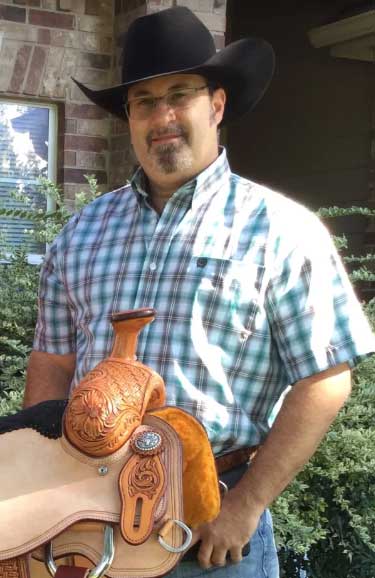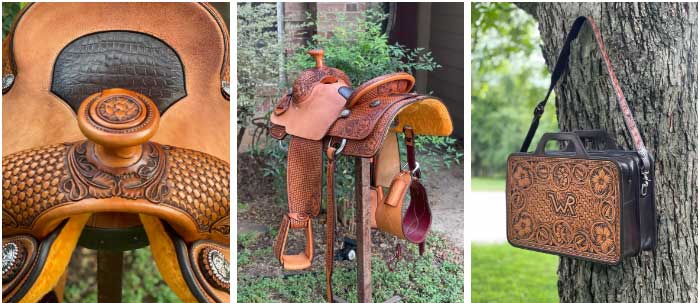
By Gene Fowler
Christmas morning, 1986, in Wilcox, Arizona. Eight-year-old Adam Tanner tears into his presents. His face lights up at the first glimpse of one particular gift emerging from the Santa-Claus-and-snow-scene wrapping. A Tandy Leathercraft Starter Kit.
“My uncle, who had made a little money doing leathercraft part-time while in college, helped me with the seven stamps and the belt, wallet, key fob and other projects in the kit,” says Adam, who today builds saddles at Tanner Custom Leather, his home-based workshop in Weatherford, Texas. “He made it look easy. I wasn’t that good at first, of course, but it was so much fun. Then I started riding my bike down to the local saddle shop to watch ’em work. So, I’ve always been drawn to it.”
Though his primary interest today is saddlemaking – Adam is currently building in 106th saddle and has 20 custom saddle orders in the pipeline – he also finds time to make one-of-a-kind belts, wallets, tack, chaps, holsters, briefcases, and rope cans. “My business slogan used to be Everything but Boots and Shoes,” he jokes.
Growing up, Adam enjoyed an additional creative outlet, playing jazz saxophone. “I was playing in the high school jazz band when I was in seventh grade,” he recalls. “And it also put me through college with a scholarship.” Like many leather artists who explore other artforms, he sees parallels in two forms of self-expression. “They’re both therapeutic. They both can help you get on an even keel if you’re feeling a little down and out.”
In 2002, his leatherwork became part-time business as he worked full time in advertising sales. Primary self-taught, Adam says he built his first saddle with the help of the humongous (708 pages!) Stohlman Encyclopedia of Saddlemaking. “It’s a great resource if you can understand what he’s saying. But if you don’t have enough knowledge going in, it can be difficult. I had to keep pulling everything apart and redoing it, so I used enough leather that i could have built two saddles.”
Around 2003, Adam got the rodeo bug and with a lick of irony for an aspiring saddlemaker, he chose bareback bronc riding as a primary event. He was involved with the Grand Canyon Pro Rodeo Association up until 2014 and with the PRCA until 2008. “I did it more for the fun, though, than the money,” he says. “I was already married with kids, so I didn’t want to be gone from home so much. I guess you could say my leather hobby paid for my rodeoin’.”
Still, it’s clear he was pretty devoted to the sport. “I broke my back in early 2008, and six months later I broke it again. Then after breaking my leg in motocross in 2009, I decided to sit out for two years.” But when he came back, he came back in style winning the GCPRA Bareback Championship in 2011.

An advocate of traditional western floral tooling. Adam credits three mentors with helping him become the saddlemaker he is today. Bob Park’s book, Creating Western Floral Designs, “really turned a light on for me,” Adam says. “I learned how to lay out my drawings, how to draw in different styles. I got a lot of clear and easy to understand concepts from him.”
Saddlemaker Terry Hensons of nearby Azle, Texas, was a big influence on Adam’s patternmaking. “He taught me building techniques that made things much easier, and I really admire the cleanliness of his designs and the quality of his craftsmanship.” And saddlemaker Keith Seidel of Cody, Wyoming, from whom Adam took design classes, also helped with the mental rigor required for the long haul of building a saddle. “I got my strongest critiques from those guys,” Adam says, “but also my highest praise.”
With their youngest child grown and out of the house, Adam and his wife moved from southern Arizona to Weatherford, Texas, just west of Fort Worth, on September 1, 2016. “We had visited friends here and liked the area,” he says. “And I really like the amount of horse people here. Weatherford is known as Cutting Horse Capital of the World, and we’re just 40 minutes from Stephenville, which I say is the rodeo capital of the world. It’s got more world champions and retired rodeo guys than anywhere.”
It’s such an ideal setting, Adam continues, that he’s built 80 saddles in six years. One of those saddles, finished last September, was a special job for Adam’s 24-year-old son, Garrett. “It was his first roping saddle… his first custom saddle period. It’s got floral tooling with an alligator inlay and a recessed bound horn. It’s good to look at and when he learned he would get to keep it, he was really excited. I told him it was Merry Christmas and Happy Birthday all rolled up for several years.” Adam still keeps horses nearby and likes to do some ropin’ himself.

Ain’t saying he’s forgot about Arizona, though. He was back home this past June, demonstrating the process of saddlemaking and the materials you need to pursue it, during all three days of the Ranching Heritage Festival in Willcox, his old hometown. The festivities celebrated 150 years of the area ranching and Adam shared the tradition-exhibiting limelight with a blacksmith, a farrier and an exponent of Dutch Oven Cooking. (Also, the hometown of singing cowboy Rex Allen, Willcox’s Rex Allen Days wingding in October includes the raffling of a Resistol signed by George Strait.)
For years Adam sourced his leather from a legacy mid-American leather provider, but he started shopping around when prices went up and quality went down. Today, he relies on Thoroughbred Leather of Louisville, Kentucky. Thoroughbred “process leather according to ‘old world’ methods.” It’s veg-tanned leather is sourced and processed “under strict guidelines to produce specific hides for a particular product.”
Appreciative of those who helped show him the ropes, Adam pays it forward by teaching saddle making. He offers hourly rates and day rates, and he also developed an intense two-week course covering pretty much the whole shootin’ match. A Maricopa, Arizona, buddy named Travis Kading took the course about three and a half years ago. “He was a farrier and vowed he would never become a full-time saddle maker,” says Adam. “But about two years ago, he quit shoeing horses and now he builds saddles in the Gila River Valley.”
This article originally appeared on Shop Talk Magazine and is published here with permission.
There are more interesting articles in our section on Tack & Farm.
































